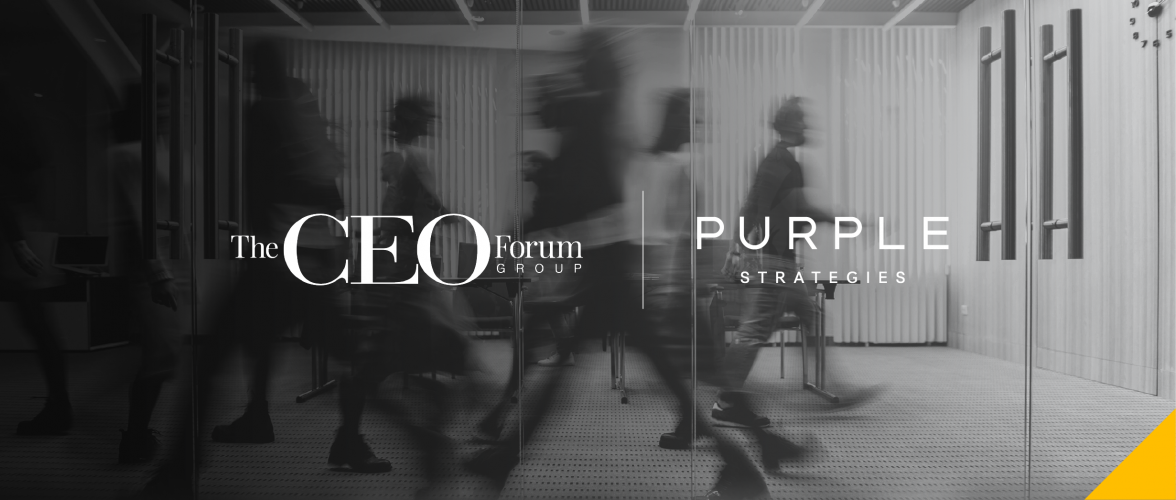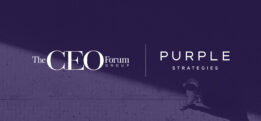5 Lessons for Leaders from The CEO Forum’s Second Transformative CEO Summit
Purple Strategies is the thought leadership and polling partner of The CEO Forum Group and Transformative CEO Summit. The CEO Forum convened its second Transformative CEO Summit on June 21, 2021, featuring more than 30 CEOs of leading companies discussing creative ways to solve today’s most pressing challenges.
Top CEOs from across the nation convened this summer for the second Transformative CEO Summit with one key topic on their minds: emerging stronger from the COVID-19 pandemic.
Leaders are eager to move on from the reactive decisions the global pandemic required them to make to keep their customers and employees safe and move toward a more proactive stance, capitalizing on lessons learned and on their own successful navigation of a year unlike any other.
This shift comes at a crucial time as leaders need to focus on how to retain their employees. According to the Department of Labor, a record 4 million people quit their jobs in April alone. That trend looks unlikely to change in the near future as a majority (65%) of the U.S. Informed Public feels very (33%) or somewhat confident (32%) in their ability to find another job role or opportunity in the next three months, according to a recent Purple Strategies* survey. The CEOs who gathered at the Summit were not daunted by this challenge; instead, they’re actually seeing this as a rare opportunity to empower employees and completely elevate the nature of work.
To accomplish this task, leaders expressed readiness to invest significantly in their workforce, especially employees who stuck with them and delivered when the organization had to make adjustments simply to keep customers and survive the pandemic. The below topics emerged across keynotes and group discussions as those most critical to CEOs, who shared their perspective on how leaders can push forward to create a workforce and working environment that are stronger than ever as the world transitions out of the coronavirus pandemic.
(1) Consider strong culture non-negotiable.
CEOs recognize that their employees’ mindsets, needs and expectations have changed since the start of the pandemic. After spending nearly 15 months away from both the office environments they’d known as well as their extended families, many workers crave a higher degree of connection and purpose from their employer than ever before. Leaders are striving to attract and retain talent by creating a compelling culture, tailored to their company and goals, that is tangible and authentic for employees no matter their work model or location.
(2) Continue to disrupt hierarchy and create opportunities to connect.
While some people may be experiencing Zoom fatigue, leaders of large companies credited the platform, and others like it, for enabling them to shake up traditional corporate organizational structures and allow their employees, regardless of level or location, to speak up and connect. By putting participants in the same size box on the same screen, the traditional “head of the table” and “back of the conference room” have been eliminated. CEOs across industries agreed this change helped lead not only to more engagement from a variety of voices, but also to more innovation – going forward, they don’t want to lose that.
(3) Walk the walk on diversity, equity and inclusion.
When asked what issue they expect their company to focus on the most over the next 12 months, more than three-fourths of CEOs selected racial and social justice. And Summit attendees stressed that DE&I is and must remain a central consideration in all business priorities and decisions – from deploying technology to providing inclusive flexibility to their returning workforce.
(4) Purposefully deploy technology to empower employees.
Transformative CEOs have a sharp focus on leveraging technology in new ways to support employees and make their work more fulfilling – while ensuring they know management isn’t trying to substitute technology for talent. In the healthcare industry, as just one example, this means adopting technology that makes completing and submitting paperwork simpler, thus freeing up time for employees to focus on what really matters and only humans can offer: patient care and support.
(5) Be flexible when defining flexibility.
The pandemic demanded a new level of flexibility from employees and employers alike, something many employees are not ready to give up. But what that flexibility looks like is something leaders agree cannot be one-size-fits-all, and can’t be found in a playbook or competitor report. It must be bespoke. Leading CEOs recommend focusing on what works best for each business function and role, and communicating about these approaches with clarity, intention, and transparency.
These lessons are more important now than ever as workers around the U.S. are reevaluating what’s most important to them in their careers and companies, and power in the talent market tips in their favor. Transformative Summit leaders have recognized this inflection point and are leading by example to shape their workplaces into environments that inspire and fulfill their employees – and become a competitive advantage as the world turns the COVID corner.
*Purple Omnibus survey of the U.S. Informed Public, n=1,001, fielded June 25 – 28, 2021.
Purple Strategies is the thought leadership and polling partner of The CEO Forum Group and Transformative CEO Summit. Purple formed 12 years ago when two political firms that were asked regularly to partner together to bring a mix of “Red” and “Blue” perspectives to corporate challenges decided to join forces. Through the years Purple has continued to evolve, bringing in diverse perspectives across a multitude of disciplines. Today, Purple is an independent, fully integrated corporate reputation strategy firm, inspired by politics, driven by data and insights, partnering with clients around the world to anticipate, navigate, and compel change. Purple blends the creativity of brand communications and the speed and strategy of political campaigns to serve Fortune 500 companies, coalitions, associations, non-profits, and some of the most recognizable brands in the world.

 AI and Paradigm Shifts on the Minds of Healthcare CEOs
AI and Paradigm Shifts on the Minds of Healthcare CEOs  Purple Strategies Elevates Three To Partnership Group
Purple Strategies Elevates Three To Partnership Group